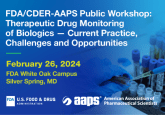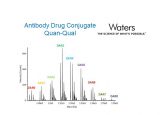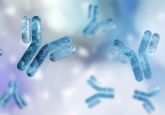Round-up of the European Bioanalysis Forum 2024
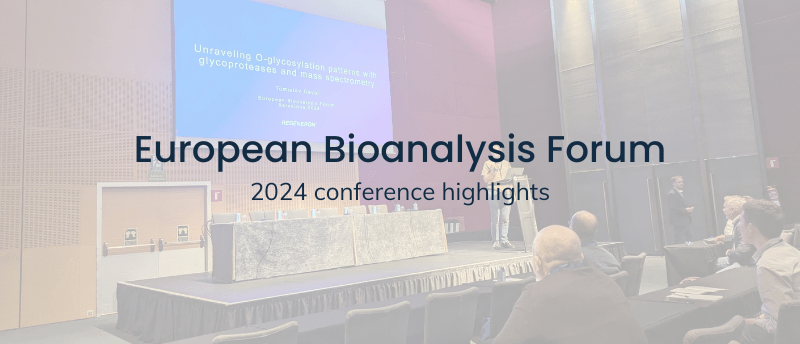
The 17th European Bioanalysis Forum (EBF; Barcelona, Spain) Open Symposium, November 20–22 2024.
The EBF Open Symposium program covered topics including ADA analysis, ‘omics, flow cytometry, PCR, LBA, LC–MS, new modalities and bioanalytical regulatory updates, among others. Below are our Editor’s highlights from the event.
Editor’s highlights from the session
Pills and thrills: a trip into the future of biopharmaceutical innovation
Peter Groenen, cerebrum DAO (Zurich, Switzerland)
Keynote Speaker Peter Groenen began the session with a reflection on the “Golden Age” of drug discovery from 1940 to 1960, characterized by a more patient-focused approach, with ample drugs coming to market and fewer regulations. Breakthroughs such as penicillin were released during this time, and despite not being the best-selling drug, it has saved most lives globally of any drug. In the current biopharmaceutical landscape, revenue is often a much greater factor than patient needs and Peter questioned whether this business model is sustainable.
The best-selling drug to date is Humira, an anti-TNF drug estimated to bring in US$264 billion by 2028. But despite a US$300 billion global spend on R&D in 2023 and 138 new drug approvals in the last 5 years (48 biologics, 90 small molecules), the ‘big 15’ pharmaceutical companies are still struggling to keep up and are increasingly relying on accruing smaller firms to maintain output by “buying innovation”.
Peter emphasized that evolution also applies to the biopharmaceutical industry and that companies must adapt to global trends to survive. Increasing drug prices is only a temporary solution and although we’ve seen much success in the start-up scene, the vast majority fail. He highlighted several transformative technologies and therapeutic approaches, such as protein degraders, gene editing, digital therapeutics and radiopharmaceuticals, amongst others, as opportunities to bridge this revenue gap. Bringing the session to a close with a positive message, Peter listed some of the ways we can harness new and emerging technologies to expedite drug development, including lab automation (robotics, speech control, autonomous AI experimentation, etc.), improved biosensors, as well as spatial genomics and single-cell analysis. The session concluded with a call to embrace evolution into different business models to help navigate the complexities of the biopharmaceutical landscape.
Why can’t we? A different mindset for singlicate analysis
Gareth Satchell, GSK (London, UK)
This talk focused on the debate between singlicate and duplicate analysis in ligand binding assays (LBAs), particularly for pharmacokinetics (PK) and soluble biomarker assays. Historically, duplicate analysis has been the default approach and is the industry standard for LBAs, but Gareth advocated for a shift towards singlicate analysis, presenting data to support its reliability and efficiency.
Duplicate analysis involves adding the processed sample to two wells, allowing comparison of variability between the wells. Gareth demonstrated that across multiple assays over several years, the absolute percentage difference between duplicates was minimal, with most results showing negligible variability and very few exceeding a 20% difference. The data presented highlighted the reproducibility of singlicate analysis, forming the foundation of GSK’s preference for this method.
When asked if the team receives pushback when suggesting singlicate analysis to CROs, Gareth acknowledges that CROs see the benefits of singlicate analysis but are often apprehensive about diverging from traditional duplicate analysis. Regarding regulatory expectations, there is currently no clear regulatory requirement that the team at GSK can see to perform duplicate analysis if the method is validated and shown to be robust. Gareth proposed using a “singlicate at first intent” approach, recommending the review of inter-well data during assay development and validation to make duplicate analysis the exception rather than the norm. To conclude the session, Gareth posed a rhetorical question to the audience: if you get no advantage from running in duplicate, why would you? This message underlines the need to challenge outdated norms and adopt practices that streamline processes without compromising data integrity.
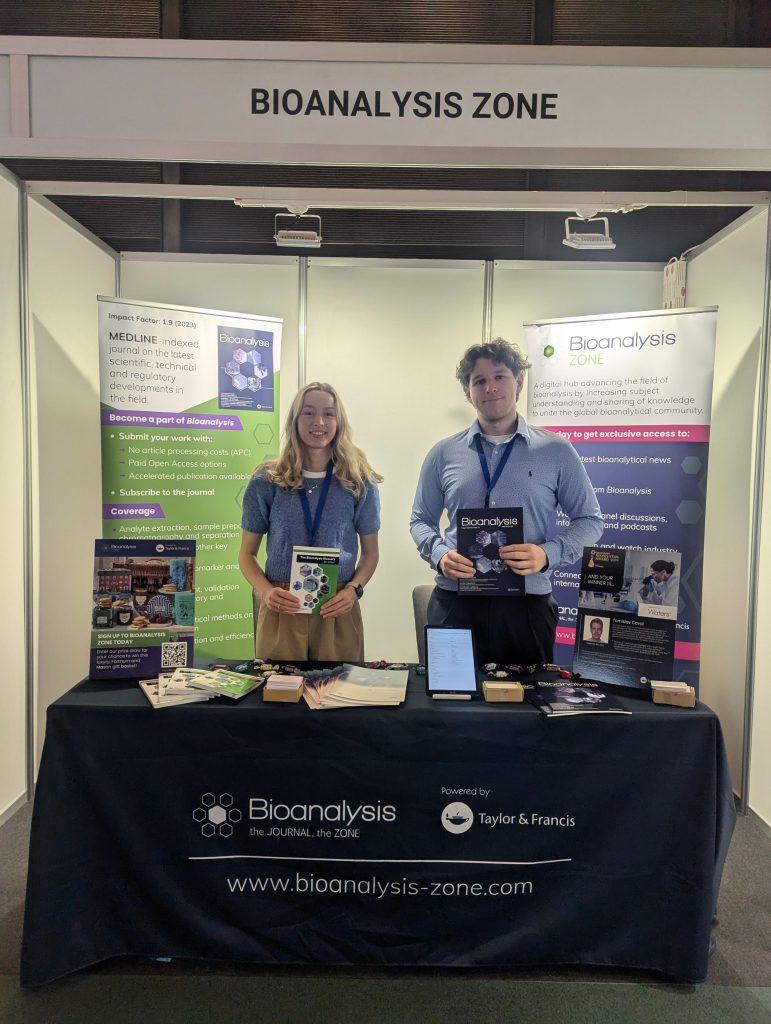
The Bioanalysis Journal and Zone team at EBF 2024: Jack Lodge, Managing Commissioning Editor and Ellen Williams, Digital Editor.
Hybrid LC–MS/MS technology becoming increasingly valuable in the bioanalysis of antibody-drug conjugates (ADCs) – bioanalytical strategy illustrated by case studies
Dominic Warrino, KCAS Bioanalytical & Biomarker Services (KS, USA)
To begin his talk, Dominic covered the core components of ADCs: the antibody, which acts as the targeting agent; the payload, the highly toxic pharmaceutical molecule; and the linker, which attaches these two elements together. The payload often takes the form of microtubule inhibitors or DNA binders. He also introduced hybrid LC–MS, the combination of LC–MS and LBAs, as a complementary technique for ADC analysis. Hybrid LC–MS combines an enrichment step, usually an antibody enrichment step on beads or columns, with the selectivity and sensitivity provided by LC–MS.
LBAs and LC–MS have various advantages; LBAs offer higher throughput and sensitivity, are more robust and require lower capital investment. However, LBAs are dependent on reagent pairs, have limited multiplexing capacity and often experience matrix interference requiring further method development. LC–MS on the other hand provides high selectivity, ready translation between species and has the capability to differentiate between endogenous substances, e.g., replacement therapy, and exogenous drugs. The lack of available reagents also does not hinder the progress of LC–MS development, as it does with LBAs.
Hybrid LC–MS aims to combine the strengths of both methods; LC–MS is used for its selectivity, multiplexing and independence from reagents, whilst LBA is used for its high sensitivity and throughput. Dominic highlighted that the synergy of both methods is particularly useful for complex analytes like ADCs and covered three case study strategies for their use with ADCs.
The application of 14C-labeled substrates for efficacy measurements in drug development
Rob Vreeken, TNO (The Hague, Netherlands)
Rob’s talk focused on the use of 14C-labelled substrates in drug development to measure metabolic flux—the flow of metabolites through biological pathways. This approach provides mechanistic insights into disease biology and drug efficacy, moving beyond traditional measurements of metabolite concentration, which often fail to capture the dynamic of in vivo processes.
Metabolic flux can be measured using isotopic tracer studies, whereby a stable or radioactive isotope is incorporated into a specific “tracer” molecule to follow the distribution, transformation and fate of the isotope. Typically, carbon or hydrogen isotopes are used as they readily incorporate into organic molecules.
Rob then described the 14C microtracer approach, a highly sensitive method allowing the measurement of pathways or processes otherwise undetectable with conventional techniques. It causes minimal disturbance of the pathway as an extremely small dose of the precursor is used. Low dose 14C can be safely used in humans in early clinical trial testing. Accelerator MS was also discussed as a powerful tool to detect and analyze 14C-labelled molecules. Accelerator MS accelerates ions to extremely high energies, much higher than traditional MS, allowing resolution of ambiguities arising in the traditional approach.
To close this session, Rob presented a case study where 14C was used in the pathway of lipogenesis, concluding that flux analysis opens the door to actual molecular dynamics.
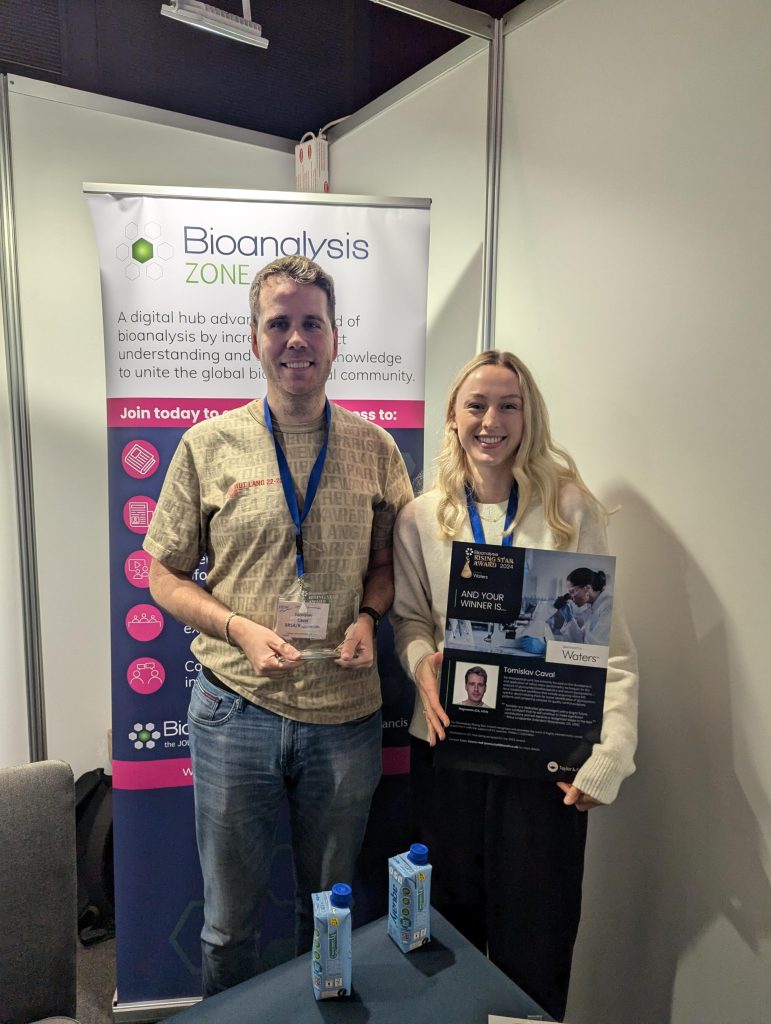
The 2024 Bioanalysis Rising Star Award winner Tomislav Caval and Digital Editor of Bioanalysis Zone Ellen Williams.
Refining method development & validation testing for ADC payloads
John Perkins, KCAS Bioanalytical & Biomarker Services
John’s presentation focused on optimizing method development and validation for analyzing ADC payloads, with an emphasis on ensuring stability and accuracy in bioanalysis. ADCs are designed to deliver potent anti-cancer agents directly to tumors, minimizing side effects and discomfort and improving patient outcomes.
There are currently 13 ADCs approved for market use, with many others in the pipeline, showcasing the growing interest and innovation in this field. Ideal payloads express low immunogenicity and have adequately high cytotoxicity. They also should be highly stable, have bystander-killing effects and be water soluble for formulation and delivery.
There are multiple approaches for measuring the free payload and typical approaches include MMAE payload assay, chromatography or MS. There are multiple considerations for free payload bioanalysis, for example, stability must be ensured to avoid artifactual payload generation during sample collection or assay procedures. Another consideration involves monitoring ADC stability in whole blood to prevent breakdown and inaccurate free payload measurements.
John highlighted that the ADCs in this particular study were stable during extraction for up to 6 hours if temperature was strictly controlled. Beyond this, instability can compromise results, imposing limitations on repeat analysis. Clinics may lack access to dry ice or ultra-low temperature storage (-80°C), creating challenges for long-term sample stability; when stored at -80°C, samples were stable for over 2,000 days, compared with 4 days when stored at -20°C. To summarise, John emphasized that method development for free payload assays must account for the whole entity (antibody, linker and payload) and that ongoing refinement of methods is crucial to ensure robust and reproducible results in the clinic.

